Relationship Between Severe Mental Illness and Primary Care: A Study
VerifiedAdded on 2022/12/22
|49
|15535
|1
Project
AI Summary
This mixed-methods study investigates the relationship between individuals with severe mental illness (SMI) and primary care services. The research aims to identify and analyze barriers to accessing primary care for SMI patients, including factors such as access to care, specialist training, communication difficulties, patient limitations, and the quality of care provided. The study employs qualitative interviews with mental health nurses, primary care providers, and patients with SMI to gather in-depth insights. Findings suggest the need to improve access to medical care and better integrate mental health and primary care services. The study also explores the significance of patient engagement, including mattering, perceived capability, and collaborative work. The study's methodology includes literature review, aims and objectives, research design, data collection, and analysis to provide evidence-based recommendations for improving the healthcare experience of people with SMI.
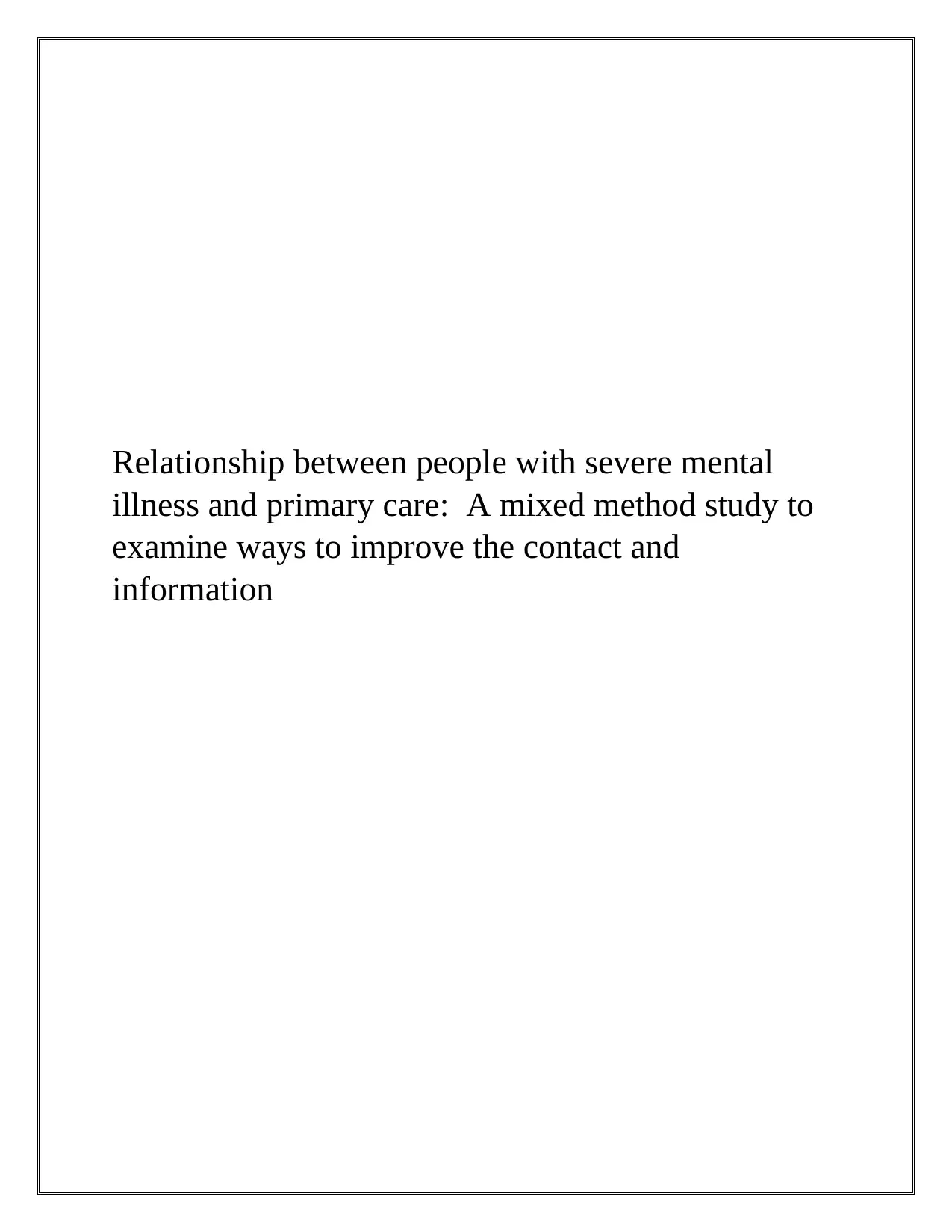
Relationship between people with severe mental
illness and primary care: A mixed method study to
examine ways to improve the contact and
information
illness and primary care: A mixed method study to
examine ways to improve the contact and
information
Paraphrase This Document
Need a fresh take? Get an instant paraphrase of this document with our AI Paraphraser

Acknowledgement
It gives me immense pleasure to finally present my dissertation “Relationship
between people with severe mental illness and primary care: A mixed method
study to examine ways to improve the contact and information”. This research
topic has helped me to gain ample knowledge in this field of study. I wish to
extend my most sincere gratitude to all those who helped to make this dissertation
a reality. I am especially grateful to my supervisor who helped me extensively in
this study. I would like to also extend my gratitude to all my friends and classmates
whose assistance proved to be milestone in accomplishing my final goal. I
acknowledge their constant support in the fulfillment of this dissertation. Needless
to say, I alone am responsible for any shortcomings in this project.
It gives me immense pleasure to finally present my dissertation “Relationship
between people with severe mental illness and primary care: A mixed method
study to examine ways to improve the contact and information”. This research
topic has helped me to gain ample knowledge in this field of study. I wish to
extend my most sincere gratitude to all those who helped to make this dissertation
a reality. I am especially grateful to my supervisor who helped me extensively in
this study. I would like to also extend my gratitude to all my friends and classmates
whose assistance proved to be milestone in accomplishing my final goal. I
acknowledge their constant support in the fulfillment of this dissertation. Needless
to say, I alone am responsible for any shortcomings in this project.
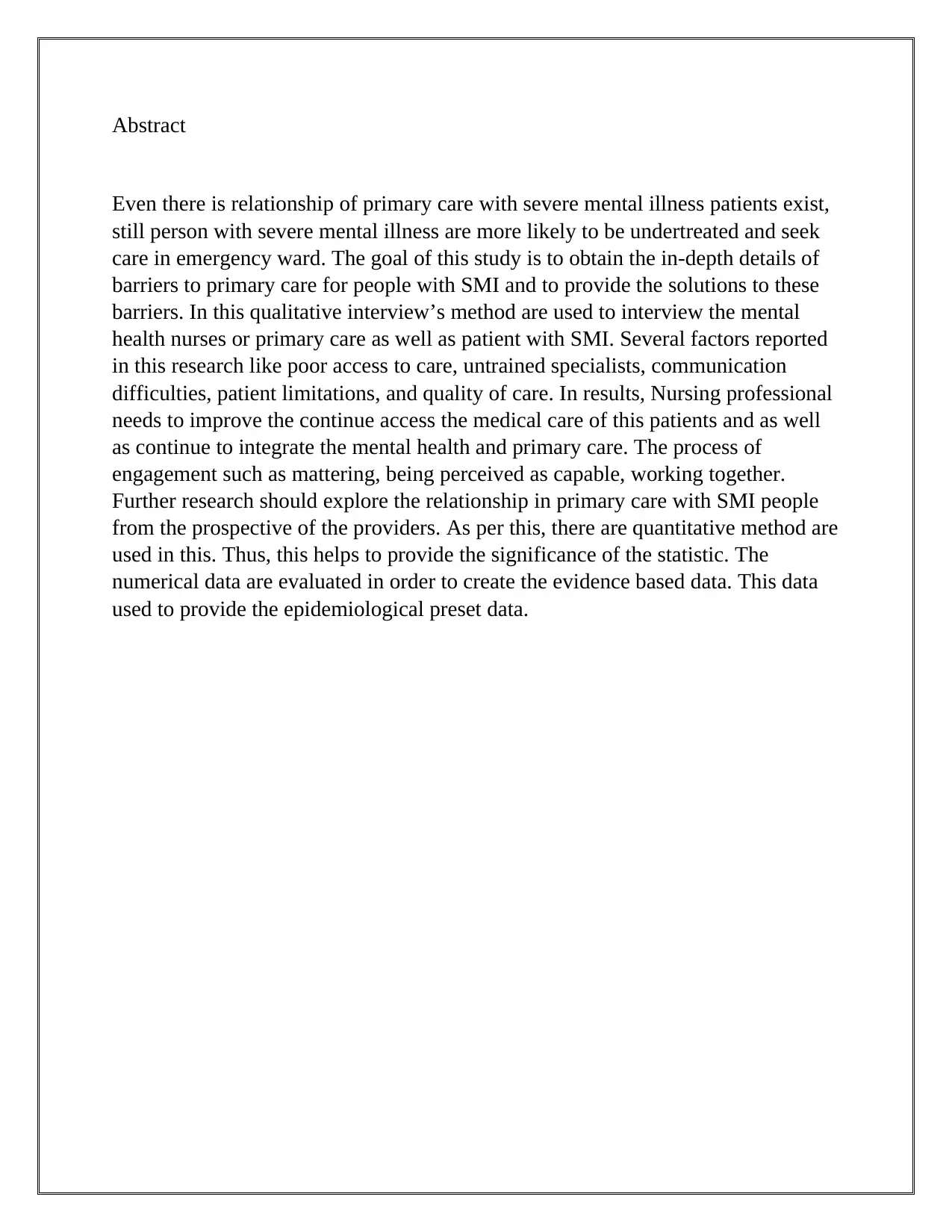
Abstract
Even there is relationship of primary care with severe mental illness patients exist,
still person with severe mental illness are more likely to be undertreated and seek
care in emergency ward. The goal of this study is to obtain the in-depth details of
barriers to primary care for people with SMI and to provide the solutions to these
barriers. In this qualitative interview’s method are used to interview the mental
health nurses or primary care as well as patient with SMI. Several factors reported
in this research like poor access to care, untrained specialists, communication
difficulties, patient limitations, and quality of care. In results, Nursing professional
needs to improve the continue access the medical care of this patients and as well
as continue to integrate the mental health and primary care. The process of
engagement such as mattering, being perceived as capable, working together.
Further research should explore the relationship in primary care with SMI people
from the prospective of the providers. As per this, there are quantitative method are
used in this. Thus, this helps to provide the significance of the statistic. The
numerical data are evaluated in order to create the evidence based data. This data
used to provide the epidemiological preset data.
Even there is relationship of primary care with severe mental illness patients exist,
still person with severe mental illness are more likely to be undertreated and seek
care in emergency ward. The goal of this study is to obtain the in-depth details of
barriers to primary care for people with SMI and to provide the solutions to these
barriers. In this qualitative interview’s method are used to interview the mental
health nurses or primary care as well as patient with SMI. Several factors reported
in this research like poor access to care, untrained specialists, communication
difficulties, patient limitations, and quality of care. In results, Nursing professional
needs to improve the continue access the medical care of this patients and as well
as continue to integrate the mental health and primary care. The process of
engagement such as mattering, being perceived as capable, working together.
Further research should explore the relationship in primary care with SMI people
from the prospective of the providers. As per this, there are quantitative method are
used in this. Thus, this helps to provide the significance of the statistic. The
numerical data are evaluated in order to create the evidence based data. This data
used to provide the epidemiological preset data.
⊘ This is a preview!⊘
Do you want full access?
Subscribe today to unlock all pages.

Trusted by 1+ million students worldwide
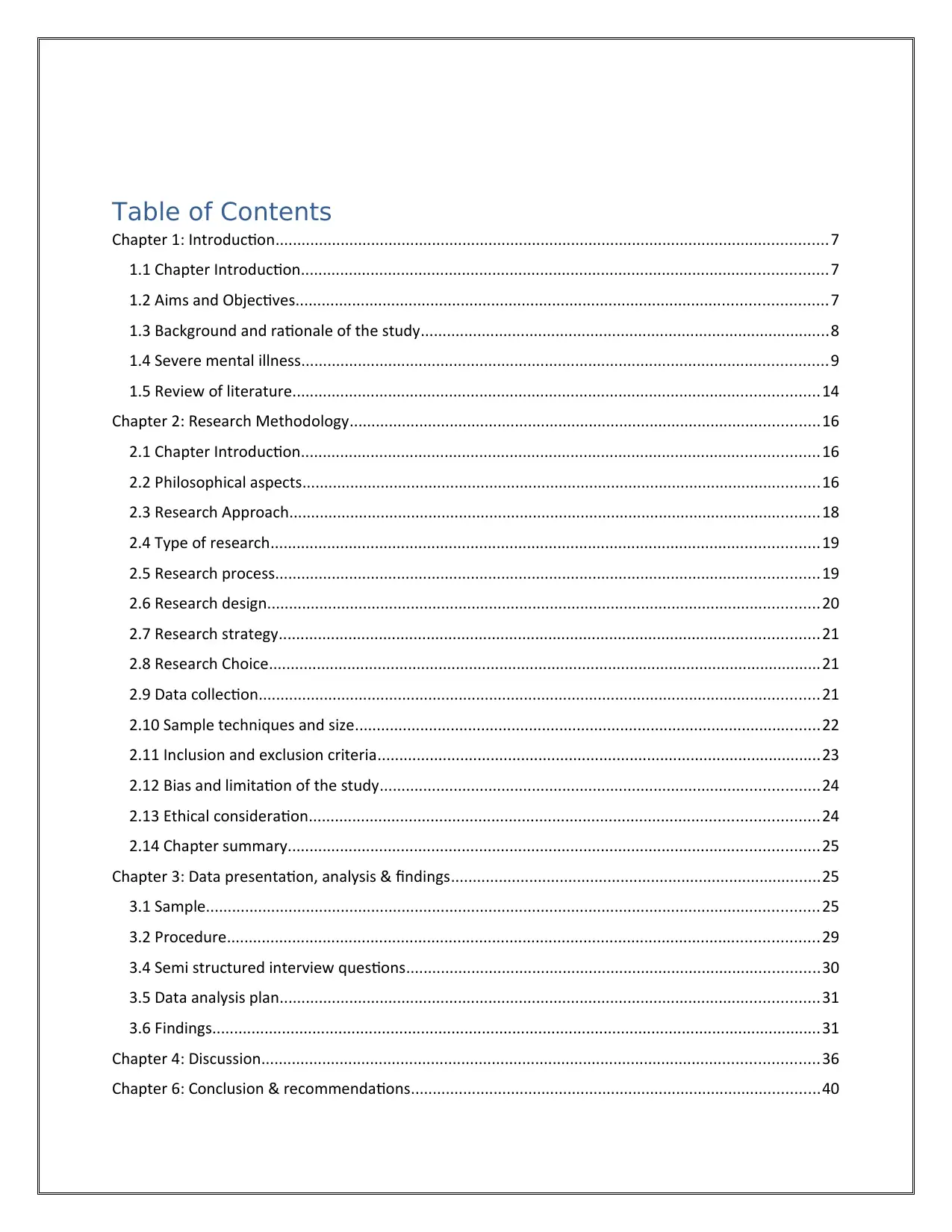
Table of Contents
Chapter 1: Introduction...............................................................................................................................7
1.1 Chapter Introduction.........................................................................................................................7
1.2 Aims and Objectives..........................................................................................................................7
1.3 Background and rationale of the study..............................................................................................8
1.4 Severe mental illness.........................................................................................................................9
1.5 Review of literature.........................................................................................................................14
Chapter 2: Research Methodology............................................................................................................16
2.1 Chapter Introduction.......................................................................................................................16
2.2 Philosophical aspects.......................................................................................................................16
2.3 Research Approach..........................................................................................................................18
2.4 Type of research..............................................................................................................................19
2.5 Research process.............................................................................................................................19
2.6 Research design...............................................................................................................................20
2.7 Research strategy............................................................................................................................21
2.8 Research Choice...............................................................................................................................21
2.9 Data collection.................................................................................................................................21
2.10 Sample techniques and size...........................................................................................................22
2.11 Inclusion and exclusion criteria......................................................................................................23
2.12 Bias and limitation of the study.....................................................................................................24
2.13 Ethical consideration.....................................................................................................................24
2.14 Chapter summary..........................................................................................................................25
Chapter 3: Data presentation, analysis & findings.....................................................................................25
3.1 Sample.............................................................................................................................................25
3.2 Procedure........................................................................................................................................29
3.4 Semi structured interview questions...............................................................................................30
3.5 Data analysis plan............................................................................................................................31
3.6 Findings............................................................................................................................................31
Chapter 4: Discussion................................................................................................................................36
Chapter 6: Conclusion & recommendations..............................................................................................40
Chapter 1: Introduction...............................................................................................................................7
1.1 Chapter Introduction.........................................................................................................................7
1.2 Aims and Objectives..........................................................................................................................7
1.3 Background and rationale of the study..............................................................................................8
1.4 Severe mental illness.........................................................................................................................9
1.5 Review of literature.........................................................................................................................14
Chapter 2: Research Methodology............................................................................................................16
2.1 Chapter Introduction.......................................................................................................................16
2.2 Philosophical aspects.......................................................................................................................16
2.3 Research Approach..........................................................................................................................18
2.4 Type of research..............................................................................................................................19
2.5 Research process.............................................................................................................................19
2.6 Research design...............................................................................................................................20
2.7 Research strategy............................................................................................................................21
2.8 Research Choice...............................................................................................................................21
2.9 Data collection.................................................................................................................................21
2.10 Sample techniques and size...........................................................................................................22
2.11 Inclusion and exclusion criteria......................................................................................................23
2.12 Bias and limitation of the study.....................................................................................................24
2.13 Ethical consideration.....................................................................................................................24
2.14 Chapter summary..........................................................................................................................25
Chapter 3: Data presentation, analysis & findings.....................................................................................25
3.1 Sample.............................................................................................................................................25
3.2 Procedure........................................................................................................................................29
3.4 Semi structured interview questions...............................................................................................30
3.5 Data analysis plan............................................................................................................................31
3.6 Findings............................................................................................................................................31
Chapter 4: Discussion................................................................................................................................36
Chapter 6: Conclusion & recommendations..............................................................................................40
Paraphrase This Document
Need a fresh take? Get an instant paraphrase of this document with our AI Paraphraser

6.1 Conclusion.......................................................................................................................................40
6.2 Recommendations...........................................................................................................................40
References.................................................................................................................................................41
6.2 Recommendations...........................................................................................................................40
References.................................................................................................................................................41
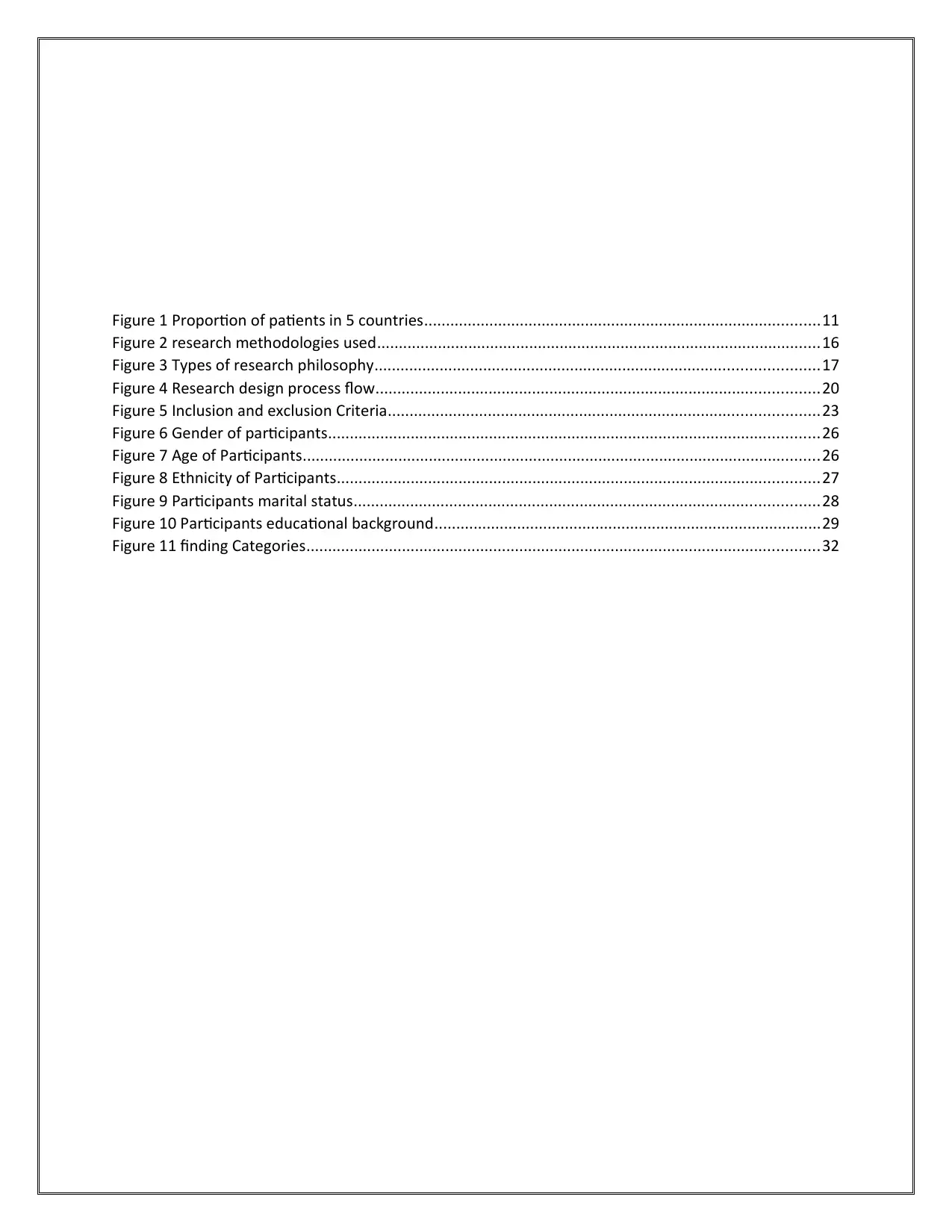
Figure 1 Proportion of patients in 5 countries...........................................................................................11
Figure 2 research methodologies used......................................................................................................16
Figure 3 Types of research philosophy......................................................................................................17
Figure 4 Research design process flow......................................................................................................20
Figure 5 Inclusion and exclusion Criteria...................................................................................................23
Figure 6 Gender of participants.................................................................................................................26
Figure 7 Age of Participants.......................................................................................................................26
Figure 8 Ethnicity of Participants...............................................................................................................27
Figure 9 Participants marital status...........................................................................................................28
Figure 10 Participants educational background.........................................................................................29
Figure 11 finding Categories......................................................................................................................32
Figure 2 research methodologies used......................................................................................................16
Figure 3 Types of research philosophy......................................................................................................17
Figure 4 Research design process flow......................................................................................................20
Figure 5 Inclusion and exclusion Criteria...................................................................................................23
Figure 6 Gender of participants.................................................................................................................26
Figure 7 Age of Participants.......................................................................................................................26
Figure 8 Ethnicity of Participants...............................................................................................................27
Figure 9 Participants marital status...........................................................................................................28
Figure 10 Participants educational background.........................................................................................29
Figure 11 finding Categories......................................................................................................................32
⊘ This is a preview!⊘
Do you want full access?
Subscribe today to unlock all pages.

Trusted by 1+ million students worldwide
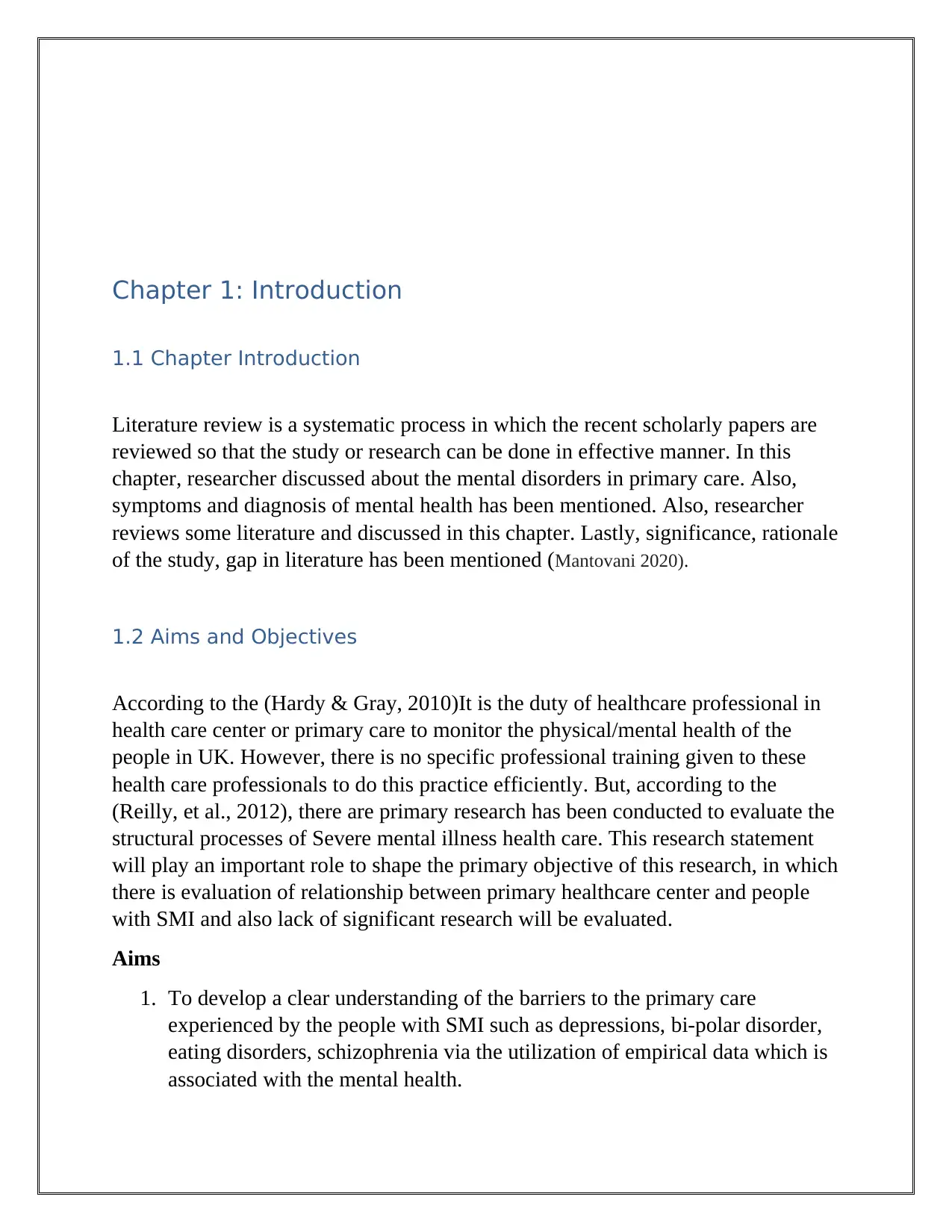
Chapter 1: Introduction
1.1 Chapter Introduction
Literature review is a systematic process in which the recent scholarly papers are
reviewed so that the study or research can be done in effective manner. In this
chapter, researcher discussed about the mental disorders in primary care. Also,
symptoms and diagnosis of mental health has been mentioned. Also, researcher
reviews some literature and discussed in this chapter. Lastly, significance, rationale
of the study, gap in literature has been mentioned (Mantovani 2020).
1.2 Aims and Objectives
According to the (Hardy & Gray, 2010)It is the duty of healthcare professional in
health care center or primary care to monitor the physical/mental health of the
people in UK. However, there is no specific professional training given to these
health care professionals to do this practice efficiently. But, according to the
(Reilly, et al., 2012), there are primary research has been conducted to evaluate the
structural processes of Severe mental illness health care. This research statement
will play an important role to shape the primary objective of this research, in which
there is evaluation of relationship between primary healthcare center and people
with SMI and also lack of significant research will be evaluated.
Aims
1. To develop a clear understanding of the barriers to the primary care
experienced by the people with SMI such as depressions, bi-polar disorder,
eating disorders, schizophrenia via the utilization of empirical data which is
associated with the mental health.
1.1 Chapter Introduction
Literature review is a systematic process in which the recent scholarly papers are
reviewed so that the study or research can be done in effective manner. In this
chapter, researcher discussed about the mental disorders in primary care. Also,
symptoms and diagnosis of mental health has been mentioned. Also, researcher
reviews some literature and discussed in this chapter. Lastly, significance, rationale
of the study, gap in literature has been mentioned (Mantovani 2020).
1.2 Aims and Objectives
According to the (Hardy & Gray, 2010)It is the duty of healthcare professional in
health care center or primary care to monitor the physical/mental health of the
people in UK. However, there is no specific professional training given to these
health care professionals to do this practice efficiently. But, according to the
(Reilly, et al., 2012), there are primary research has been conducted to evaluate the
structural processes of Severe mental illness health care. This research statement
will play an important role to shape the primary objective of this research, in which
there is evaluation of relationship between primary healthcare center and people
with SMI and also lack of significant research will be evaluated.
Aims
1. To develop a clear understanding of the barriers to the primary care
experienced by the people with SMI such as depressions, bi-polar disorder,
eating disorders, schizophrenia via the utilization of empirical data which is
associated with the mental health.
Paraphrase This Document
Need a fresh take? Get an instant paraphrase of this document with our AI Paraphraser
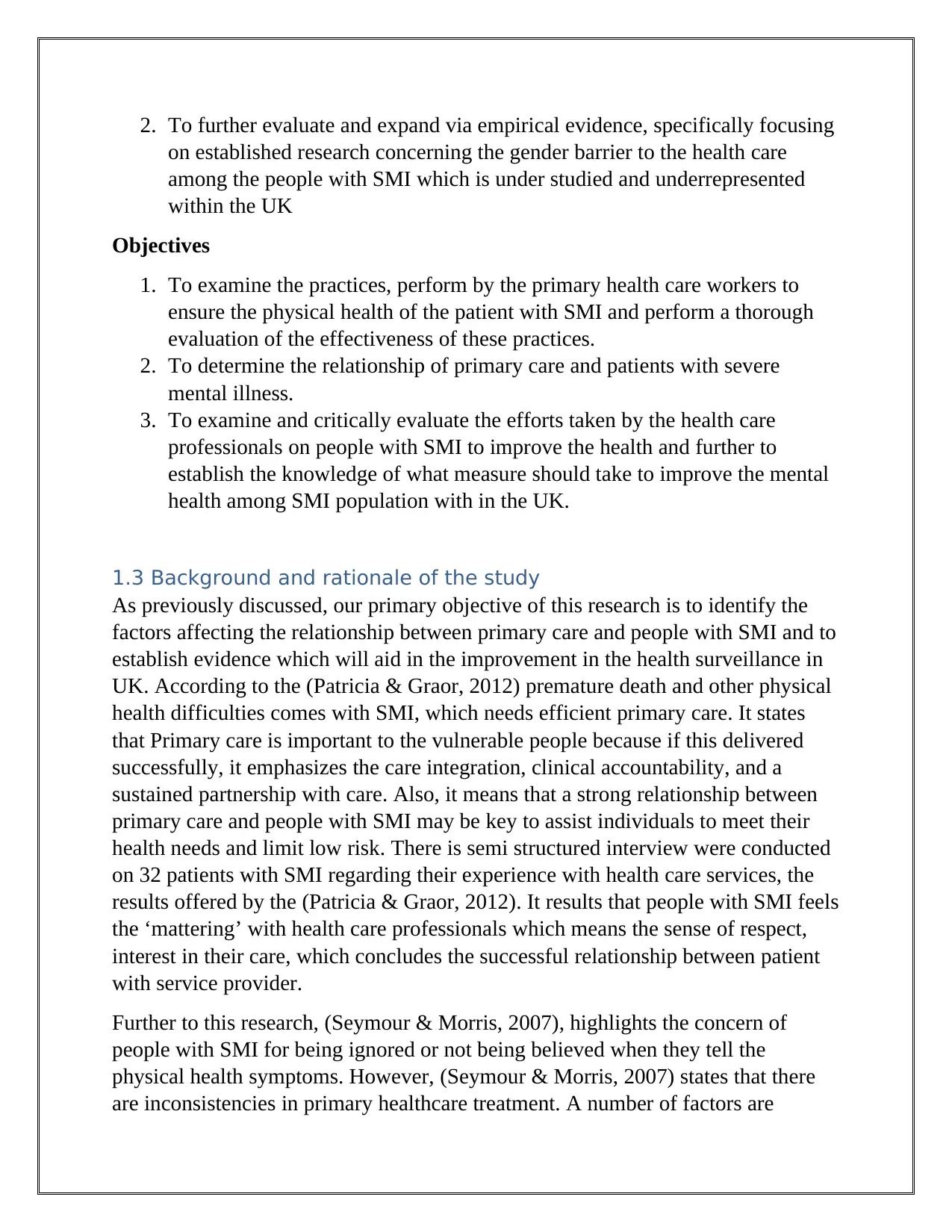
2. To further evaluate and expand via empirical evidence, specifically focusing
on established research concerning the gender barrier to the health care
among the people with SMI which is under studied and underrepresented
within the UK
Objectives
1. To examine the practices, perform by the primary health care workers to
ensure the physical health of the patient with SMI and perform a thorough
evaluation of the effectiveness of these practices.
2. To determine the relationship of primary care and patients with severe
mental illness.
3. To examine and critically evaluate the efforts taken by the health care
professionals on people with SMI to improve the health and further to
establish the knowledge of what measure should take to improve the mental
health among SMI population with in the UK.
1.3 Background and rationale of the study
As previously discussed, our primary objective of this research is to identify the
factors affecting the relationship between primary care and people with SMI and to
establish evidence which will aid in the improvement in the health surveillance in
UK. According to the (Patricia & Graor, 2012) premature death and other physical
health difficulties comes with SMI, which needs efficient primary care. It states
that Primary care is important to the vulnerable people because if this delivered
successfully, it emphasizes the care integration, clinical accountability, and a
sustained partnership with care. Also, it means that a strong relationship between
primary care and people with SMI may be key to assist individuals to meet their
health needs and limit low risk. There is semi structured interview were conducted
on 32 patients with SMI regarding their experience with health care services, the
results offered by the (Patricia & Graor, 2012). It results that people with SMI feels
the ‘mattering’ with health care professionals which means the sense of respect,
interest in their care, which concludes the successful relationship between patient
with service provider.
Further to this research, (Seymour & Morris, 2007), highlights the concern of
people with SMI for being ignored or not being believed when they tell the
physical health symptoms. However, (Seymour & Morris, 2007) states that there
are inconsistencies in primary healthcare treatment. A number of factors are
on established research concerning the gender barrier to the health care
among the people with SMI which is under studied and underrepresented
within the UK
Objectives
1. To examine the practices, perform by the primary health care workers to
ensure the physical health of the patient with SMI and perform a thorough
evaluation of the effectiveness of these practices.
2. To determine the relationship of primary care and patients with severe
mental illness.
3. To examine and critically evaluate the efforts taken by the health care
professionals on people with SMI to improve the health and further to
establish the knowledge of what measure should take to improve the mental
health among SMI population with in the UK.
1.3 Background and rationale of the study
As previously discussed, our primary objective of this research is to identify the
factors affecting the relationship between primary care and people with SMI and to
establish evidence which will aid in the improvement in the health surveillance in
UK. According to the (Patricia & Graor, 2012) premature death and other physical
health difficulties comes with SMI, which needs efficient primary care. It states
that Primary care is important to the vulnerable people because if this delivered
successfully, it emphasizes the care integration, clinical accountability, and a
sustained partnership with care. Also, it means that a strong relationship between
primary care and people with SMI may be key to assist individuals to meet their
health needs and limit low risk. There is semi structured interview were conducted
on 32 patients with SMI regarding their experience with health care services, the
results offered by the (Patricia & Graor, 2012). It results that people with SMI feels
the ‘mattering’ with health care professionals which means the sense of respect,
interest in their care, which concludes the successful relationship between patient
with service provider.
Further to this research, (Seymour & Morris, 2007), highlights the concern of
people with SMI for being ignored or not being believed when they tell the
physical health symptoms. However, (Seymour & Morris, 2007) states that there
are inconsistencies in primary healthcare treatment. A number of factors are
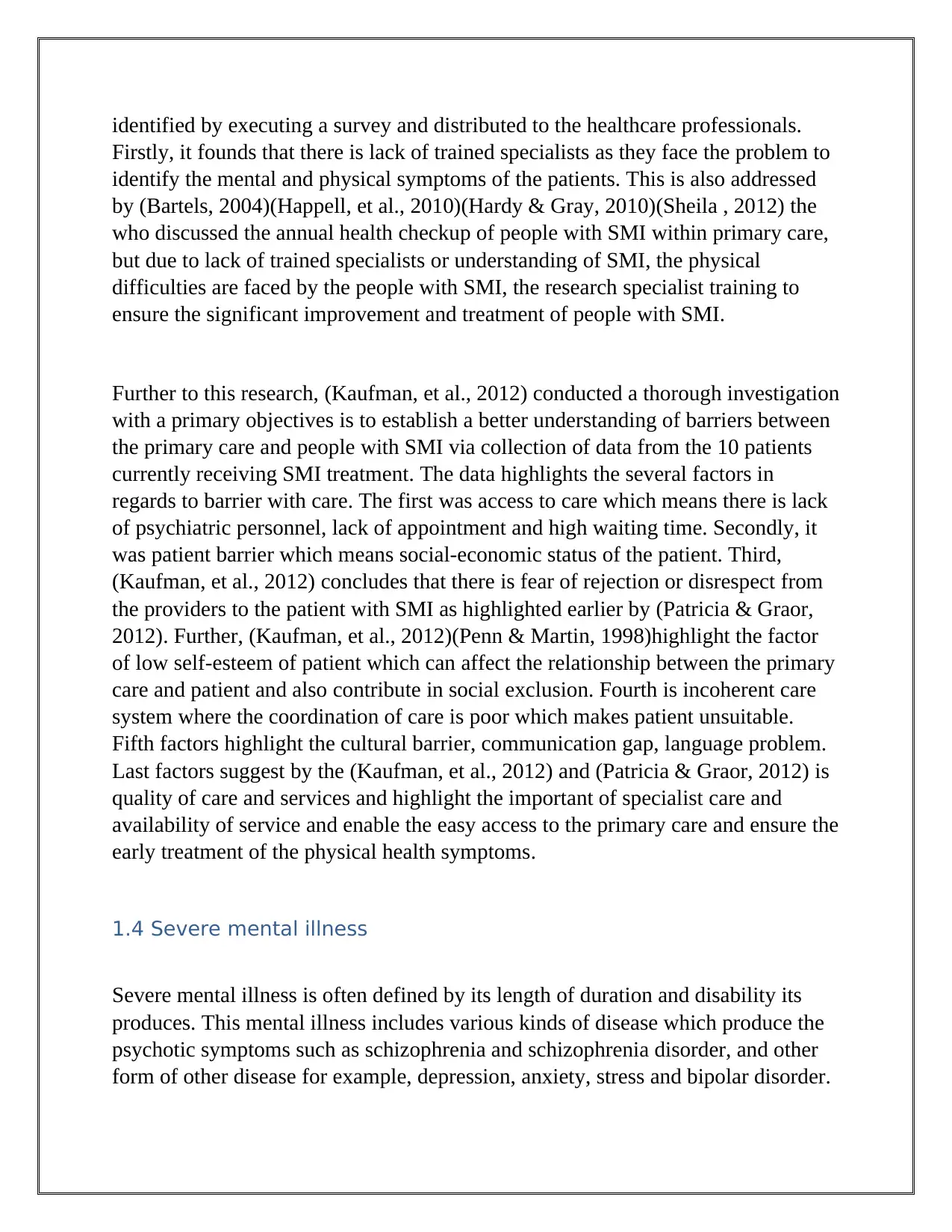
identified by executing a survey and distributed to the healthcare professionals.
Firstly, it founds that there is lack of trained specialists as they face the problem to
identify the mental and physical symptoms of the patients. This is also addressed
by (Bartels, 2004)(Happell, et al., 2010)(Hardy & Gray, 2010)(Sheila , 2012) the
who discussed the annual health checkup of people with SMI within primary care,
but due to lack of trained specialists or understanding of SMI, the physical
difficulties are faced by the people with SMI, the research specialist training to
ensure the significant improvement and treatment of people with SMI.
Further to this research, (Kaufman, et al., 2012) conducted a thorough investigation
with a primary objectives is to establish a better understanding of barriers between
the primary care and people with SMI via collection of data from the 10 patients
currently receiving SMI treatment. The data highlights the several factors in
regards to barrier with care. The first was access to care which means there is lack
of psychiatric personnel, lack of appointment and high waiting time. Secondly, it
was patient barrier which means social-economic status of the patient. Third,
(Kaufman, et al., 2012) concludes that there is fear of rejection or disrespect from
the providers to the patient with SMI as highlighted earlier by (Patricia & Graor,
2012). Further, (Kaufman, et al., 2012)(Penn & Martin, 1998)highlight the factor
of low self-esteem of patient which can affect the relationship between the primary
care and patient and also contribute in social exclusion. Fourth is incoherent care
system where the coordination of care is poor which makes patient unsuitable.
Fifth factors highlight the cultural barrier, communication gap, language problem.
Last factors suggest by the (Kaufman, et al., 2012) and (Patricia & Graor, 2012) is
quality of care and services and highlight the important of specialist care and
availability of service and enable the easy access to the primary care and ensure the
early treatment of the physical health symptoms.
1.4 Severe mental illness
Severe mental illness is often defined by its length of duration and disability its
produces. This mental illness includes various kinds of disease which produce the
psychotic symptoms such as schizophrenia and schizophrenia disorder, and other
form of other disease for example, depression, anxiety, stress and bipolar disorder.
Firstly, it founds that there is lack of trained specialists as they face the problem to
identify the mental and physical symptoms of the patients. This is also addressed
by (Bartels, 2004)(Happell, et al., 2010)(Hardy & Gray, 2010)(Sheila , 2012) the
who discussed the annual health checkup of people with SMI within primary care,
but due to lack of trained specialists or understanding of SMI, the physical
difficulties are faced by the people with SMI, the research specialist training to
ensure the significant improvement and treatment of people with SMI.
Further to this research, (Kaufman, et al., 2012) conducted a thorough investigation
with a primary objectives is to establish a better understanding of barriers between
the primary care and people with SMI via collection of data from the 10 patients
currently receiving SMI treatment. The data highlights the several factors in
regards to barrier with care. The first was access to care which means there is lack
of psychiatric personnel, lack of appointment and high waiting time. Secondly, it
was patient barrier which means social-economic status of the patient. Third,
(Kaufman, et al., 2012) concludes that there is fear of rejection or disrespect from
the providers to the patient with SMI as highlighted earlier by (Patricia & Graor,
2012). Further, (Kaufman, et al., 2012)(Penn & Martin, 1998)highlight the factor
of low self-esteem of patient which can affect the relationship between the primary
care and patient and also contribute in social exclusion. Fourth is incoherent care
system where the coordination of care is poor which makes patient unsuitable.
Fifth factors highlight the cultural barrier, communication gap, language problem.
Last factors suggest by the (Kaufman, et al., 2012) and (Patricia & Graor, 2012) is
quality of care and services and highlight the important of specialist care and
availability of service and enable the easy access to the primary care and ensure the
early treatment of the physical health symptoms.
1.4 Severe mental illness
Severe mental illness is often defined by its length of duration and disability its
produces. This mental illness includes various kinds of disease which produce the
psychotic symptoms such as schizophrenia and schizophrenia disorder, and other
form of other disease for example, depression, anxiety, stress and bipolar disorder.
⊘ This is a preview!⊘
Do you want full access?
Subscribe today to unlock all pages.

Trusted by 1+ million students worldwide
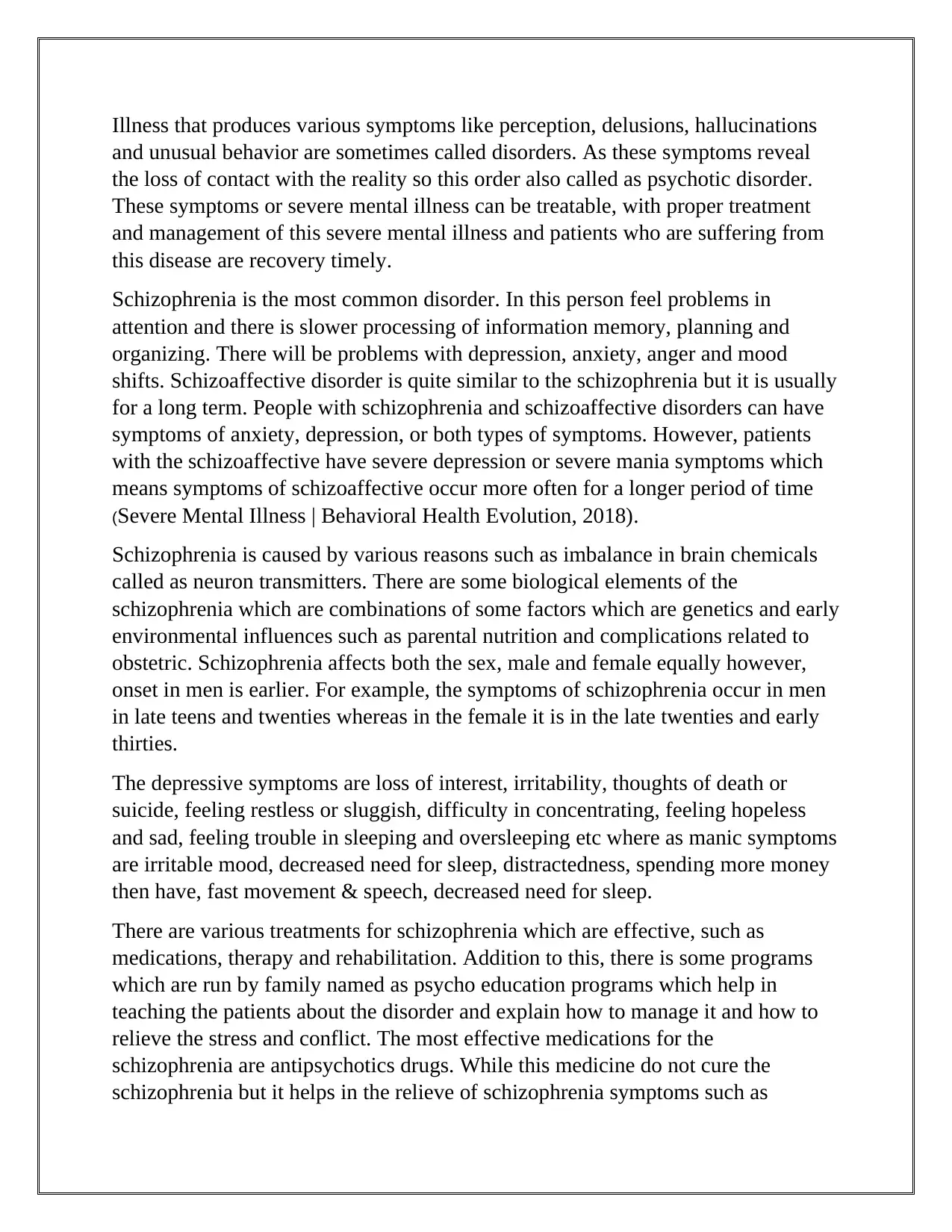
Illness that produces various symptoms like perception, delusions, hallucinations
and unusual behavior are sometimes called disorders. As these symptoms reveal
the loss of contact with the reality so this order also called as psychotic disorder.
These symptoms or severe mental illness can be treatable, with proper treatment
and management of this severe mental illness and patients who are suffering from
this disease are recovery timely.
Schizophrenia is the most common disorder. In this person feel problems in
attention and there is slower processing of information memory, planning and
organizing. There will be problems with depression, anxiety, anger and mood
shifts. Schizoaffective disorder is quite similar to the schizophrenia but it is usually
for a long term. People with schizophrenia and schizoaffective disorders can have
symptoms of anxiety, depression, or both types of symptoms. However, patients
with the schizoaffective have severe depression or severe mania symptoms which
means symptoms of schizoaffective occur more often for a longer period of time
(Severe Mental Illness | Behavioral Health Evolution, 2018).
Schizophrenia is caused by various reasons such as imbalance in brain chemicals
called as neuron transmitters. There are some biological elements of the
schizophrenia which are combinations of some factors which are genetics and early
environmental influences such as parental nutrition and complications related to
obstetric. Schizophrenia affects both the sex, male and female equally however,
onset in men is earlier. For example, the symptoms of schizophrenia occur in men
in late teens and twenties whereas in the female it is in the late twenties and early
thirties.
The depressive symptoms are loss of interest, irritability, thoughts of death or
suicide, feeling restless or sluggish, difficulty in concentrating, feeling hopeless
and sad, feeling trouble in sleeping and oversleeping etc where as manic symptoms
are irritable mood, decreased need for sleep, distractedness, spending more money
then have, fast movement & speech, decreased need for sleep.
There are various treatments for schizophrenia which are effective, such as
medications, therapy and rehabilitation. Addition to this, there is some programs
which are run by family named as psycho education programs which help in
teaching the patients about the disorder and explain how to manage it and how to
relieve the stress and conflict. The most effective medications for the
schizophrenia are antipsychotics drugs. While this medicine do not cure the
schizophrenia but it helps in the relieve of schizophrenia symptoms such as
and unusual behavior are sometimes called disorders. As these symptoms reveal
the loss of contact with the reality so this order also called as psychotic disorder.
These symptoms or severe mental illness can be treatable, with proper treatment
and management of this severe mental illness and patients who are suffering from
this disease are recovery timely.
Schizophrenia is the most common disorder. In this person feel problems in
attention and there is slower processing of information memory, planning and
organizing. There will be problems with depression, anxiety, anger and mood
shifts. Schizoaffective disorder is quite similar to the schizophrenia but it is usually
for a long term. People with schizophrenia and schizoaffective disorders can have
symptoms of anxiety, depression, or both types of symptoms. However, patients
with the schizoaffective have severe depression or severe mania symptoms which
means symptoms of schizoaffective occur more often for a longer period of time
(Severe Mental Illness | Behavioral Health Evolution, 2018).
Schizophrenia is caused by various reasons such as imbalance in brain chemicals
called as neuron transmitters. There are some biological elements of the
schizophrenia which are combinations of some factors which are genetics and early
environmental influences such as parental nutrition and complications related to
obstetric. Schizophrenia affects both the sex, male and female equally however,
onset in men is earlier. For example, the symptoms of schizophrenia occur in men
in late teens and twenties whereas in the female it is in the late twenties and early
thirties.
The depressive symptoms are loss of interest, irritability, thoughts of death or
suicide, feeling restless or sluggish, difficulty in concentrating, feeling hopeless
and sad, feeling trouble in sleeping and oversleeping etc where as manic symptoms
are irritable mood, decreased need for sleep, distractedness, spending more money
then have, fast movement & speech, decreased need for sleep.
There are various treatments for schizophrenia which are effective, such as
medications, therapy and rehabilitation. Addition to this, there is some programs
which are run by family named as psycho education programs which help in
teaching the patients about the disorder and explain how to manage it and how to
relieve the stress and conflict. The most effective medications for the
schizophrenia are antipsychotics drugs. While this medicine do not cure the
schizophrenia but it helps in the relieve of schizophrenia symptoms such as
Paraphrase This Document
Need a fresh take? Get an instant paraphrase of this document with our AI Paraphraser
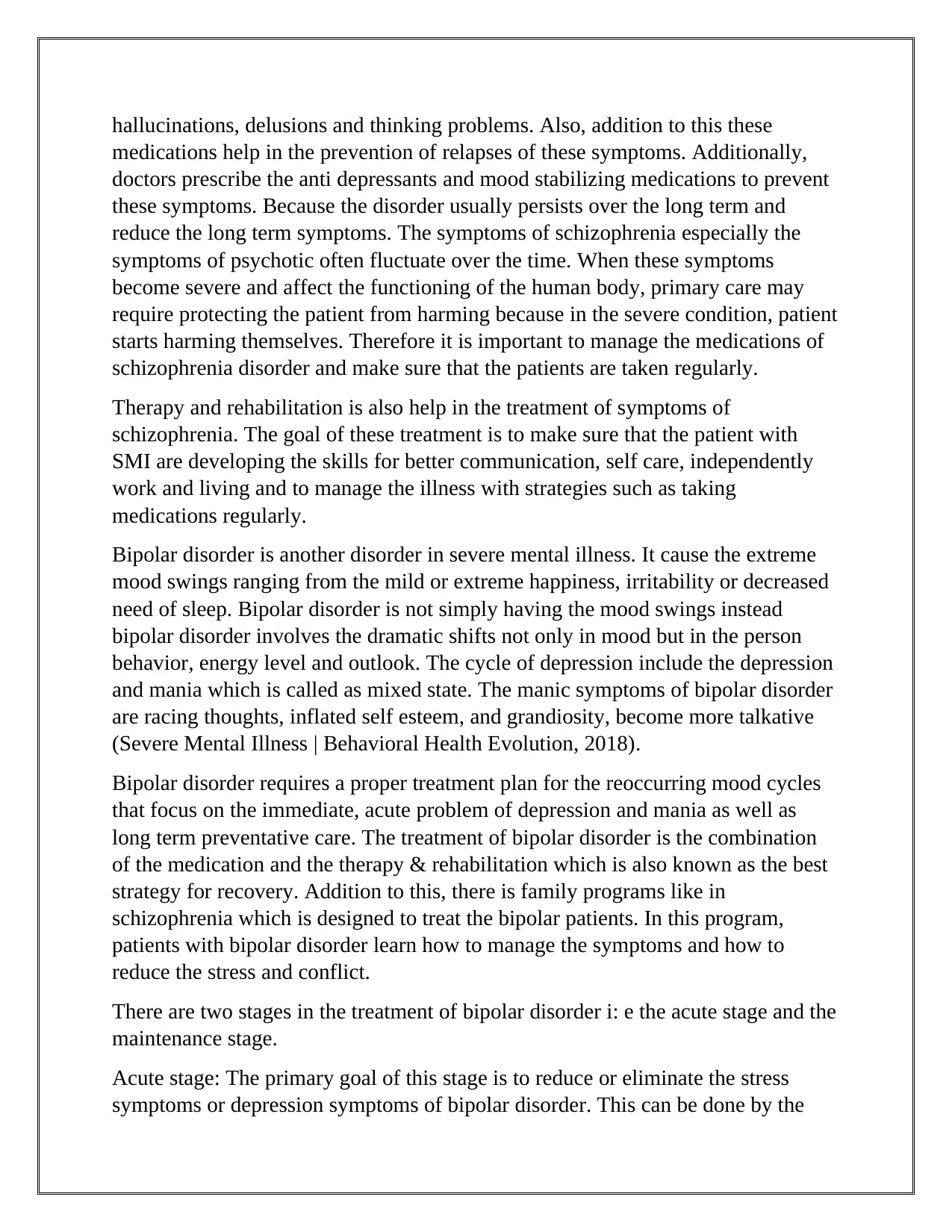
hallucinations, delusions and thinking problems. Also, addition to this these
medications help in the prevention of relapses of these symptoms. Additionally,
doctors prescribe the anti depressants and mood stabilizing medications to prevent
these symptoms. Because the disorder usually persists over the long term and
reduce the long term symptoms. The symptoms of schizophrenia especially the
symptoms of psychotic often fluctuate over the time. When these symptoms
become severe and affect the functioning of the human body, primary care may
require protecting the patient from harming because in the severe condition, patient
starts harming themselves. Therefore it is important to manage the medications of
schizophrenia disorder and make sure that the patients are taken regularly.
Therapy and rehabilitation is also help in the treatment of symptoms of
schizophrenia. The goal of these treatment is to make sure that the patient with
SMI are developing the skills for better communication, self care, independently
work and living and to manage the illness with strategies such as taking
medications regularly.
Bipolar disorder is another disorder in severe mental illness. It cause the extreme
mood swings ranging from the mild or extreme happiness, irritability or decreased
need of sleep. Bipolar disorder is not simply having the mood swings instead
bipolar disorder involves the dramatic shifts not only in mood but in the person
behavior, energy level and outlook. The cycle of depression include the depression
and mania which is called as mixed state. The manic symptoms of bipolar disorder
are racing thoughts, inflated self esteem, and grandiosity, become more talkative
(Severe Mental Illness | Behavioral Health Evolution, 2018).
Bipolar disorder requires a proper treatment plan for the reoccurring mood cycles
that focus on the immediate, acute problem of depression and mania as well as
long term preventative care. The treatment of bipolar disorder is the combination
of the medication and the therapy & rehabilitation which is also known as the best
strategy for recovery. Addition to this, there is family programs like in
schizophrenia which is designed to treat the bipolar patients. In this program,
patients with bipolar disorder learn how to manage the symptoms and how to
reduce the stress and conflict.
There are two stages in the treatment of bipolar disorder i: e the acute stage and the
maintenance stage.
Acute stage: The primary goal of this stage is to reduce or eliminate the stress
symptoms or depression symptoms of bipolar disorder. This can be done by the
medications help in the prevention of relapses of these symptoms. Additionally,
doctors prescribe the anti depressants and mood stabilizing medications to prevent
these symptoms. Because the disorder usually persists over the long term and
reduce the long term symptoms. The symptoms of schizophrenia especially the
symptoms of psychotic often fluctuate over the time. When these symptoms
become severe and affect the functioning of the human body, primary care may
require protecting the patient from harming because in the severe condition, patient
starts harming themselves. Therefore it is important to manage the medications of
schizophrenia disorder and make sure that the patients are taken regularly.
Therapy and rehabilitation is also help in the treatment of symptoms of
schizophrenia. The goal of these treatment is to make sure that the patient with
SMI are developing the skills for better communication, self care, independently
work and living and to manage the illness with strategies such as taking
medications regularly.
Bipolar disorder is another disorder in severe mental illness. It cause the extreme
mood swings ranging from the mild or extreme happiness, irritability or decreased
need of sleep. Bipolar disorder is not simply having the mood swings instead
bipolar disorder involves the dramatic shifts not only in mood but in the person
behavior, energy level and outlook. The cycle of depression include the depression
and mania which is called as mixed state. The manic symptoms of bipolar disorder
are racing thoughts, inflated self esteem, and grandiosity, become more talkative
(Severe Mental Illness | Behavioral Health Evolution, 2018).
Bipolar disorder requires a proper treatment plan for the reoccurring mood cycles
that focus on the immediate, acute problem of depression and mania as well as
long term preventative care. The treatment of bipolar disorder is the combination
of the medication and the therapy & rehabilitation which is also known as the best
strategy for recovery. Addition to this, there is family programs like in
schizophrenia which is designed to treat the bipolar patients. In this program,
patients with bipolar disorder learn how to manage the symptoms and how to
reduce the stress and conflict.
There are two stages in the treatment of bipolar disorder i: e the acute stage and the
maintenance stage.
Acute stage: The primary goal of this stage is to reduce or eliminate the stress
symptoms or depression symptoms of bipolar disorder. This can be done by the
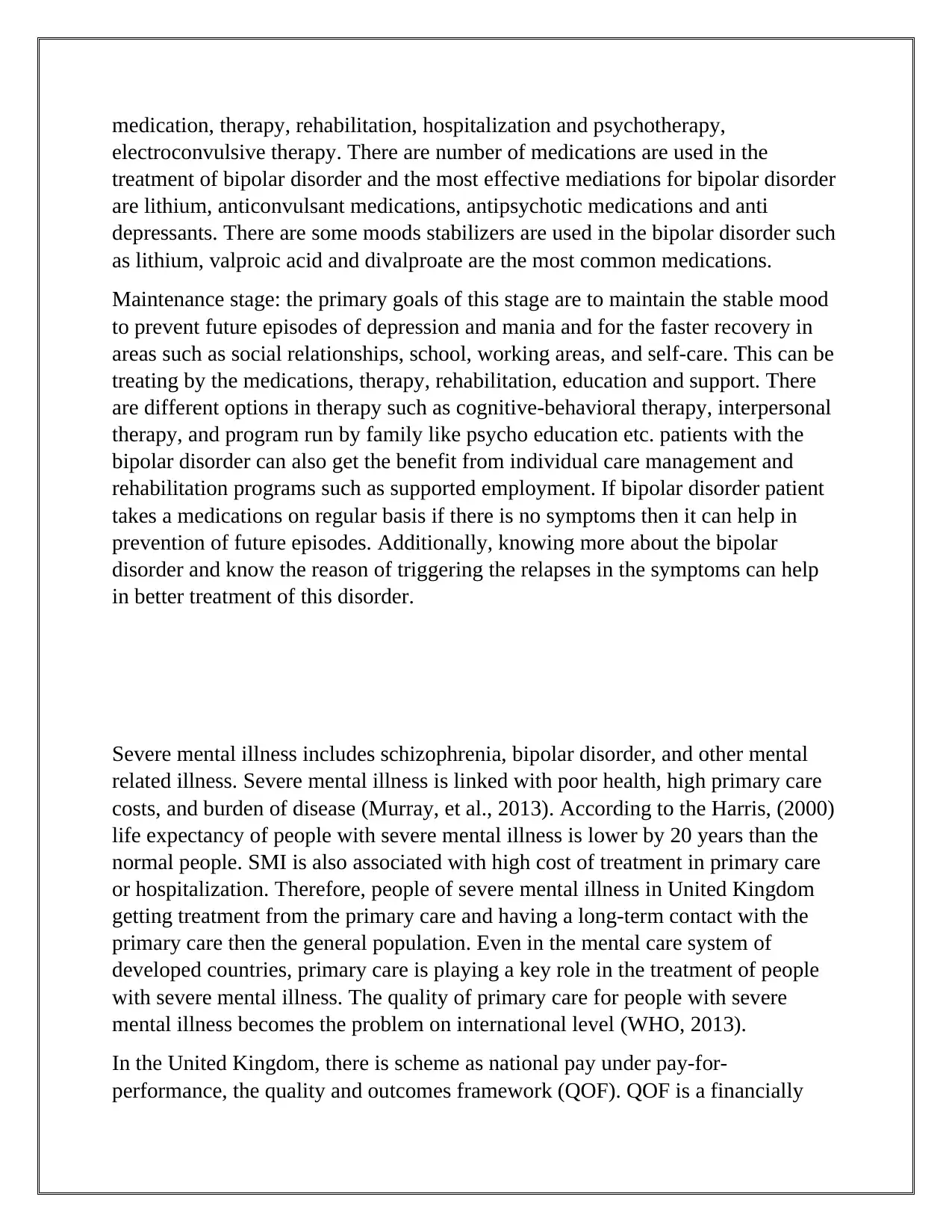
medication, therapy, rehabilitation, hospitalization and psychotherapy,
electroconvulsive therapy. There are number of medications are used in the
treatment of bipolar disorder and the most effective mediations for bipolar disorder
are lithium, anticonvulsant medications, antipsychotic medications and anti
depressants. There are some moods stabilizers are used in the bipolar disorder such
as lithium, valproic acid and divalproate are the most common medications.
Maintenance stage: the primary goals of this stage are to maintain the stable mood
to prevent future episodes of depression and mania and for the faster recovery in
areas such as social relationships, school, working areas, and self-care. This can be
treating by the medications, therapy, rehabilitation, education and support. There
are different options in therapy such as cognitive-behavioral therapy, interpersonal
therapy, and program run by family like psycho education etc. patients with the
bipolar disorder can also get the benefit from individual care management and
rehabilitation programs such as supported employment. If bipolar disorder patient
takes a medications on regular basis if there is no symptoms then it can help in
prevention of future episodes. Additionally, knowing more about the bipolar
disorder and know the reason of triggering the relapses in the symptoms can help
in better treatment of this disorder.
Severe mental illness includes schizophrenia, bipolar disorder, and other mental
related illness. Severe mental illness is linked with poor health, high primary care
costs, and burden of disease (Murray, et al., 2013). According to the Harris, (2000)
life expectancy of people with severe mental illness is lower by 20 years than the
normal people. SMI is also associated with high cost of treatment in primary care
or hospitalization. Therefore, people of severe mental illness in United Kingdom
getting treatment from the primary care and having a long-term contact with the
primary care then the general population. Even in the mental care system of
developed countries, primary care is playing a key role in the treatment of people
with severe mental illness. The quality of primary care for people with severe
mental illness becomes the problem on international level (WHO, 2013).
In the United Kingdom, there is scheme as national pay under pay-for-
performance, the quality and outcomes framework (QOF). QOF is a financially
electroconvulsive therapy. There are number of medications are used in the
treatment of bipolar disorder and the most effective mediations for bipolar disorder
are lithium, anticonvulsant medications, antipsychotic medications and anti
depressants. There are some moods stabilizers are used in the bipolar disorder such
as lithium, valproic acid and divalproate are the most common medications.
Maintenance stage: the primary goals of this stage are to maintain the stable mood
to prevent future episodes of depression and mania and for the faster recovery in
areas such as social relationships, school, working areas, and self-care. This can be
treating by the medications, therapy, rehabilitation, education and support. There
are different options in therapy such as cognitive-behavioral therapy, interpersonal
therapy, and program run by family like psycho education etc. patients with the
bipolar disorder can also get the benefit from individual care management and
rehabilitation programs such as supported employment. If bipolar disorder patient
takes a medications on regular basis if there is no symptoms then it can help in
prevention of future episodes. Additionally, knowing more about the bipolar
disorder and know the reason of triggering the relapses in the symptoms can help
in better treatment of this disorder.
Severe mental illness includes schizophrenia, bipolar disorder, and other mental
related illness. Severe mental illness is linked with poor health, high primary care
costs, and burden of disease (Murray, et al., 2013). According to the Harris, (2000)
life expectancy of people with severe mental illness is lower by 20 years than the
normal people. SMI is also associated with high cost of treatment in primary care
or hospitalization. Therefore, people of severe mental illness in United Kingdom
getting treatment from the primary care and having a long-term contact with the
primary care then the general population. Even in the mental care system of
developed countries, primary care is playing a key role in the treatment of people
with severe mental illness. The quality of primary care for people with severe
mental illness becomes the problem on international level (WHO, 2013).
In the United Kingdom, there is scheme as national pay under pay-for-
performance, the quality and outcomes framework (QOF). QOF is a financially
⊘ This is a preview!⊘
Do you want full access?
Subscribe today to unlock all pages.

Trusted by 1+ million students worldwide
1 out of 49
Related Documents
Your All-in-One AI-Powered Toolkit for Academic Success.
+13062052269
info@desklib.com
Available 24*7 on WhatsApp / Email
![[object Object]](/_next/static/media/star-bottom.7253800d.svg)
Unlock your academic potential
Copyright © 2020–2025 A2Z Services. All Rights Reserved. Developed and managed by ZUCOL.





